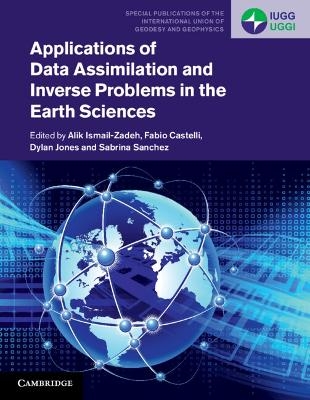
Applications of Data Assimilation and Inverse Problems in the Earth Sciences
Cambridge University Press (Verlag)
978-1-009-18040-5 (ISBN)
Many contemporary problems within the Earth sciences are complex, and require an interdisciplinary approach. This book provides a comprehensive reference on data assimilation and inverse problems, as well as their applications across a broad range of geophysical disciplines. With contributions from world leading researchers, it covers basic knowledge about geophysical inversions and data assimilation and discusses a range of important research issues and applications in atmospheric and cryospheric sciences, hydrology, geochronology, geodesy, geodynamics, geomagnetism, gravity, near-Earth electron radiation, seismology, and volcanology. Highlighting the importance of research in data assimilation for understanding dynamical processes of the Earth and its space environment and for predictability, it summarizes relevant new advances in data assimilation and inverse problems related to different geophysical fields. Covering both theory and practical applications, it is an ideal reference for researchers and graduate students within the geosciences who are interested in inverse problems, data assimilation, predictability, and numerical methods.
Alik Ismail-Zadeh is a Research Professor at the Institute of Applied Geosciences, Karlsruhe Institute of Technology. He is the winner of several awards, and a member of Academia Europaea, fellow of American Geological Union, International Science Council, International Union of Geodesy and Geophysics, and honorary fellow of the Royal Astronomical Society. Ismail-Zadeh has written or edited three previous books: Computational Methods for Geodynamics (Cambridge University Press, 2010); Extreme Natural Hazards, Disaster Risks, and Societal Implications (Cambridge University Press, 2014); and Data Driven Numerical Modelling in Geodynamics (2016). Fabio Castelli is Professor of Hydrology at the University of Florence and a member of the American Geological Union, European Geological Union and the International Association for Hydro-Environment Engineering and Research. He is an Associate to the UNESCO Chair on the Prevention and Sustainable Management of Geo-Hydrological Hazards. Castelli's projects focus on drought and water resources management, flood forecasting systems and flood risk management, with particular focus on preservation of cultural heritage. Dylan Jones is a Professor at the University of Toronto, and an atmospheric physicist who held a Tier II Canada Research Chair from 2004–2014. His research uses data assimilation and inverse modelling techniques to integrate measurements of atmospheric composition with global models of chemistry and transport to develop a better understanding of how pollution influences the atmosphere. Sabrina Sanchez is a geophysicist at the Institut de Physique du Globe de Paris with a primary research interest in geomagnetism. Her main work consists of using data assimilation to constrain Earth's core dynamics over the past millennia, combining palaeomagnetic and historical data together with dynamo simulations. She has also worked with solar and planetary dynamos.
Part I. Introduction: 1. Inverse Problems and Data Assimilation in Earth Sciences Alik Ismail-Zadeh, Fabio Castelli, Dylan Jones and Sabrina Sanchez; 2. Emerging Directions in Geophysical Inversion Andrew P. Valentine and Malcolm Sambridge; 3. A Tutorial on Bayesian Data Assimilation Colin Grudzien and Marc Bocquet; 4. Third-Order Sensitivity Analysis, Uncertainty Quantification, Data Assimilation, Forward and Inverse Predictive Modelling for Large-Scale Systems Dan Cacuci; Part II. 'Fluid' Earth Applications from the Surface to the Space: 5. Data Assimilation of Seasonal Snow Manuela Girotto, Keith N. Musselman and Richard L. H. Essery; 6. Data Assimilation in Glaciology Mathieu Morlighem and Daniel Goldberg; 7. Data Assimilation in Hydrological Sciences Fabio Castelli; 8. Data Assimilation and Inverse Modelling of Atmospheric Trace Constituents Dylan Jones; 9. Data Assimilation of Volcanic Clouds: Recent Advances and Implications on Operational Forecasts Arnau Folch and Leonardo Mingari; 10. Data Assimilation in the Near-Earth Electron Radiation Environment Yuri Y. Shprits, Angelica M. Castillo, Nikita Aseev, Sebastian Cervantes, Ingo Michaelis, Irina Zhelavskaya, Artem Smirnov and Dedong Wang; Part III. 'Solid' Earth Applications from the Surface to the Core: 11. Trans-Dimensional Markov Chain Monte Carlo Methods Applied to Geochronology and Thermochronology Kerry Gallagher; 12. Inverse Problems in Lava Dynamics Alik Ismail-Zadeh, Alexander Korotkii, Oleg Melnik, Ilya Starodubtsev, Yulia Starodubtseva, Igor Tsepelev and Natalya Zeinalova; 13. Data Assimilation for Real-Time Shake-Mapping and Prediction of Ground Shaking in Earthquake Early Warning Mitsuyuki Hoshiba; 14. Global Seismic Tomography Using Time Domain Waveform Inversion Barbara Romanowicz; 15. Solving Larger Seismic Inverse Problems with Smarter Methods Lars Gebraad, Dirk-Philip van Herwaarden, Solvi Thrastarson and Andreas Fichtner; 16. Using Joint Inversion as a Hypothesis Testing Tool Max Moorkamp; 17. Crustal Structure and Moho Depth in the Tibetan Plateau from Inverse Modelling of Gravity Data Shuanggen Jin and S. B. Xuan; 18. Geodetic Inversions and Applications in Geodynamics Grigory Steblov and Irina Vladimirova; 19. Data Assimilation in Geodynamics: Methods and Applications Alik Ismail-Zadeh, Igor Tsepelev and Alexander Korotkii; 20. Geodynamic Data Assimilation: Techniques and Observables to Construct and Constrain Time-Dependent Earth Models Hans-Peter Bunge, Andre Horbach, Lorenzo Colli, Siavash Ghelichkhan, Berta Vilacís and Jorge N. Hayek; 21. Understanding and Predicting Geomagnetic Secular Variation via Data Assimilation Weijia Kuang, Kyle Gwirtz, Andrew Tangborn and Mathias Morzfeld; 22. Point-wise and Spectral Observations in Geomagnetic Data Assimilation, the Importance of Localization Sabrina Sanchez; Index.
| Erscheinungsdatum | 10.07.2023 |
|---|---|
| Reihe/Serie | Special Publications of the International Union of Geodesy and Geophysics |
| Zusatzinfo | Worked examples or Exercises |
| Verlagsort | Cambridge |
| Sprache | englisch |
| Maße | 220 x 285 mm |
| Gewicht | 1190 g |
| Themenwelt | Mathematik / Informatik ► Mathematik ► Angewandte Mathematik |
| Naturwissenschaften ► Geowissenschaften ► Geologie | |
| ISBN-10 | 1-009-18040-1 / 1009180401 |
| ISBN-13 | 978-1-009-18040-5 / 9781009180405 |
| Zustand | Neuware |
| Haben Sie eine Frage zum Produkt? |
aus dem Bereich


